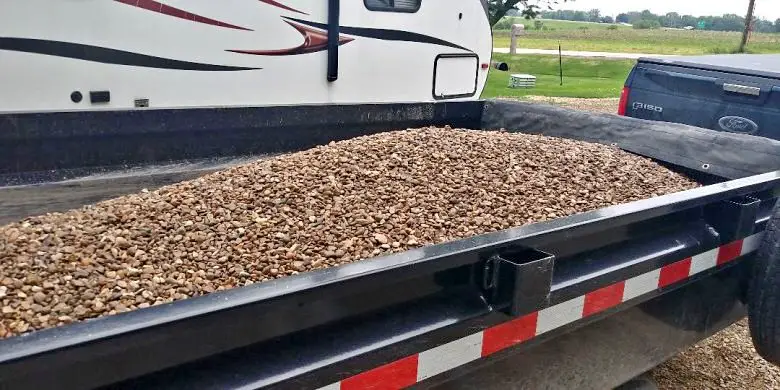River rocks are naturally smooth stones found in riverbeds and streams.
They come in different sizes, shapes, and colors, adding a natural and aesthetic appeal to landscaping projects.
Whether you’re a landscaping enthusiast with a green thumb or embarking on a construction project, the allure of river rock cannot be denied.
Its timeless beauty and versatility make it a popular choice for enhancing outdoor spaces, creating pathways, defining garden borders, or adding a touch of tranquility to water features.
But here’s the catch: how do you move these magnificent rocks by hand?
The thought of transporting those hefty stones may seem daunting, leaving you wondering if there’s a secret method or a set of superpowers involved.
Fear not, as I’ll explain the various strategies you can use to get the job done effectively.
Easiest Ways to Move River Rock by Hand
Moving river rock can be accomplished using a variety of techniques, depending on the size and quantity of the rocks.
Let’s explore the manual and mechanical approaches.
- Manual Techniques
1. Shoveling
Shoveling is a fundamental technique for moving river rock. To shovel effectively…
- Position yourself close to the rock, with feet shoulder-width apart for stability
- Place the shovel blade under the rock and use your leg muscles to lift it, rather than straining your back
- Use your body weight to pivot and transfer the rock to the desired location
2. Using Buckets
Buckets are a great option for moving smaller quantities of river rock. Follow these steps for efficient bucket usage.

- Fill the bucket with an appropriate amount of rock, considering its weight and your ability to carry it comfortably
- Squat down, engaging your leg muscles, and lift the bucket using both hands
- Carry the bucket close to your body and distribute the weight evenly for balance
- When emptying the bucket, bend your knees and release the rocks gently, maintaining control throughout the process
Related: Is Lava Rock Good For Drainage?
3. Hand Picking
This is suitable for specific projects that require a more selective approach. Follow these guidelines for efficient hand-picking.
- Choose rocks that are within your lifting capability and match the desired size and shape
- Squat or kneel, engaging your leg muscles, and lift the rock using both hands
- Maintain a steady pace to avoid straining your back and to ensure an efficient workflow
You can also use some mechanical help to make things easier.
- Mechanical Assistance
4. Using Wheelbarrows
These are a valuable tool for transporting larger quantities of river rock. Follow these steps for efficient wheelbarrow usage.
- Load the river rock into the wheelbarrow, distributing the weight evenly to maintain balance
- Position yourself behind the wheelbarrow handles, with knees slightly bent and back straight
- Use your leg muscles to push the wheelbarrow forward, taking care not to overload it beyond your capacity
- When unloading, approach the desired location, tilt the wheelbarrow forward, and gently release the rocks
5. Implementing Carts or Dollies
Carts or dollies can be useful for moving substantial amounts of river rock over longer distances. Consider these steps.
- Load the rocks onto the cart or dolly, ensuring an even distribution of weight for stability
- Use the handles or grips provided to maneuver the cart or dolly smoothly
- Be cautious of your surroundings and ensure a clear pathway to avoid accidents
Related: How to Clean Limestone Landscape Rocks
Tools and Equipment Required for Moving River Rock by Hand

Here’s a comprehensive list of what you’ll need.
Shovels
Invest in sturdy shovels with durable handles and broad heads.
A flat-headed shovel is ideal for lifting larger river rocks, while a spade or trenching shovel can be useful for smaller rocks and precision work.
Wheelbarrows
A reliable wheelbarrow will make transporting the rock easier. Look for a sturdy, well-balanced option with pneumatic tires to handle the weight and navigate different terrains.
Buckets
Depending on the size of the rock, buckets can be a convenient option for transporting smaller quantities.
Use durable, heavy-duty buckets with comfortable handles for efficient carrying.
Gloves
Wear sturdy work gloves to protect your hands from rough edges, blisters, and potential splinters. Look for gloves with good grip and flexibility for better control.
Safety Goggles
River rock may occasionally chip or release small particles during transport. Protect your eyes with safety goggles to prevent any debris from causing injury.
Factors to Consider Before Moving River Rock
These are some key factors to consider to ensure a smooth and efficient process.
Quantity and Weight

Assessing the quantity and weight of the river rock you need to move is important for planning and executing the task efficiently.
This step allows you to estimate the amount of effort required and determine the appropriate number of people or equipment needed.
It also helps you determine the size and capacity of containers, such as buckets or wheelbarrows, for transporting the rock.
By understanding the quantity and weight, you can avoid overexertion and ensure a manageable workload.
If you have a large amount of river rock to move, consider breaking the task into smaller, more manageable sections.
This can help prevent fatigue and reduce the risk of injuries. It’s also essential to pace yourself and take breaks as needed, especially for prolonged projects.
Related: How to Clean Limestone Landscape Rocks
Terrain and Accessibility
The terrain and accessibility of the location where the river rock needs to be moved play a significant role in determining the most suitable techniques and tools for the task.
If the terrain is uneven, hilly, or includes slopes, it can make the moving process more challenging.
In such cases, you may need to adjust your approach and use tools that provide better stability and control, such as wheelbarrows or carts with sturdy wheels designed for rough terrains.
If you need to navigate stairs or narrow pathways, consider the size and weight of the river rock and whether it can be safely maneuvered through such areas.
It may require additional planning and coordination to ensure smooth transport without causing damage to the surroundings.
Environmental and Safety Concerns
Consider any environmental factors or safety concerns related to the task.
Be mindful of protecting nearby plants, structures, or delicate areas during the moving process.
Also, ensure that you have proper footwear and attire to maintain your safety throughout the task.
Safety Precautions when Moving River Rocks
Moving river rock by hand can be physically demanding, so it’s essential to prioritize safety. Follow these precautions to prevent injuries.
Proper Lifting Techniques
- Bend your knees and use your leg muscles, not your back, when lifting heavy river rocks
- Maintain a straight back and avoid twisting your body while lifting or carrying rocks
- Ask for assistance or use equipment if a rock exceeds your lifting capacity
Body Mechanics
- Take breaks when needed and listen to your body to prevent fatigue and strain
- Use proper posture and avoid prolonged periods of bending or stooping
- Incorporate stretching exercises before and after the task to warm up and cool down your muscles
Personal Protective Equipment (PPE)
- Wear sturdy work gloves to protect your hands from abrasions, blisters, and potentially sharp edges
- Put on safety goggles to shield your eyes from debris or flying particles
Related
- Shadow Box Fence Pros and Cons
- Shadow Box Fence Vs Board on Board Fence (Side by Side Comparison)
- Best Paslode Framing Nailers Review
- Top 5 Freeman Framing Nailers Review
- Best Numax Finish & Framing Nailers Review
- 8 Best Metabo Framing Nailers Review
- Monument Grills Vs Weber Grills Review
- Advantages and Disadvantages of Dog Eared Fence
- How to Clean Lava Rock Landscaping: Simple Steps to Try
- How to Clean Limestone Landscape Rocks (Step by Step)
- How Long Does It Take to Move a Ton of Gravel?


